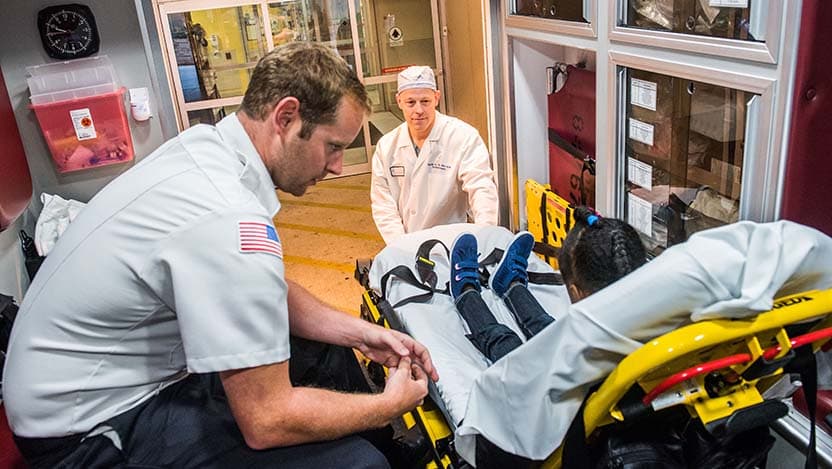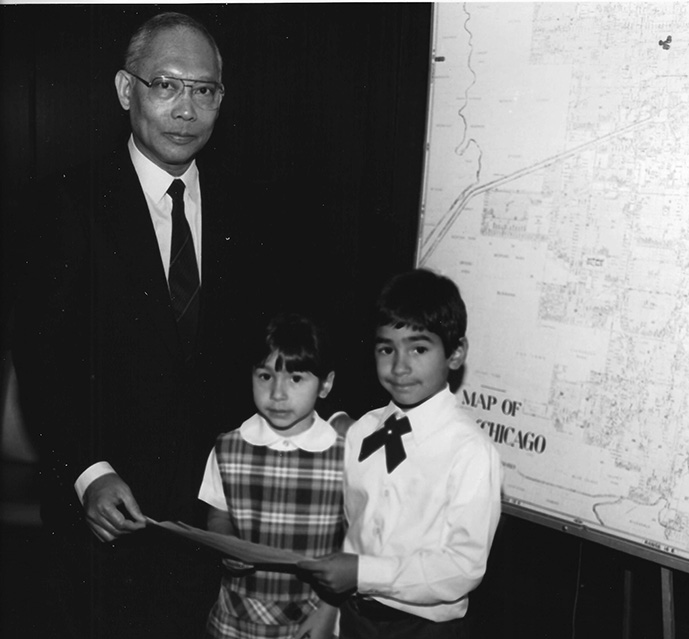Now busier than ever, Comer Children's Hospital marks 35 years of treating children with traumatic injuries

A 12-year-old boy who had been shot in the neck arrived by ambulance at the Level 1 pediatric trauma center in the University of Chicago Medicine’s Comer Children’s Hospital.
Quickly, more than a dozen doctors and nurses surrounded him as they worked to stop the bleeding and stabilize him. A specialist from the hospital’s Child Life team stood alongside the boy, calming him and explaining what the doctors and nurses were doing. Meanwhile, a member of the hospital’s Violence Recovery Team reached out to the boy’s family, providing up-to-date information on his condition and offering support, including social workers.
In critical but stable condition, the boy was wheeled into the operating room, where Comer Children’s pediatric surgeons controlled the bleeding, removed the bullet and repaired the damage it caused. The boy recovered in the pediatric intensive care unit, receiving expert, around-the-clock care for two weeks until he was well enough to return home.
“And that’s just one patient on a normal Friday afternoon,” said Jeff Murphy, DNP, RN, CEN, NEA-BC, Vice President, Women’s, Children’s, and Emergency Services and Associate Chief Nursing Officer.
The designation means the hospital has the critical resources and specialists necessary to care for children with the most severe traumatic injuries.
For decades, children who have been shot, hurt in car accidents, burned, injured in falls or had other traumatic injuries have received expert care at Comer Children’s pediatric trauma center. This month marks the 35th anniversary of the hospital’s accreditation as a level 1 pediatric trauma center.
The designation means the hospital has the critical resources and specialists necessary to care for children with the most severe traumatic injuries. Hospitals throughout the region regularly transfer patients to Comer Children’s Hospital because of their expertise in the care of injured children.
Pediatric trauma center history
Pediatric care was first offered at the University of Chicago Medicine in 1928, the same year construction began on its first children’s hospital, then called the Home for Destitute and Crippled Children.

In 1966, Wyler Children’s Hospital was built, and in 2005, it was replaced with a modern, state-of-the-art facility, Comer Children’s Hospital. It is named after the late South Side native, philanthropist and Land’s End founder Gary C. Comer.
Illinois first started to create a statewide trauma system in the 1970s, but the plan fell apart after its federal funding dried up. The system wasn’t re-established until 1986, when the Illinois Emergency Medical Services Act was amended. That year, home rule authority allowed the city of Chicago to designate trauma centers within its borders and the CDPH granted accreditation to UChicago Medicine’s children’s hospital pediatric trauma center on November 21, 1986.
Eventually, the Illinois Department of Public Health (IDPH) took over accreditation of trauma centers. On Dec. 30, 1990, UChicago Medicine also received IDPH accreditation as a level 1 pediatric trauma center. The level 1 distinction means that the highest level of quality emergency trauma care is available 24 hours a day, seven days a week.
In August 2021, the IDPH designated Comer Children’s as a Pediatric Critical Care Center (PCCC), one of just 10 PCCCs in Illinois. It recognizes the hospital for having the resources, personnel and quality infrastructure in place — such as a pediatric intensive care unit and specialty inpatient service — to meet the needs of seriously ill and injured children. It also is willing to partner with and support other hospitals that don’t have the resources to care for the sickest children.
Busiest years yet
In 2020 and 2021, Comer Children’s pediatric trauma center experienced its busiest years since the pediatric emergency room opened, in part due to a rise in gun violence.
That illustrates the critical need for pediatric trauma services on Chicago’s South Side, which UChicago Medicine Comer Children’s Hospital is committed to providing. Many communities don’t get the high level of care that South Side residents do at UChicago Medicine, said Mark Slidell, MD, Director of Pediatric Trauma.
“We provide absolutely the highest level of care for children on the South Side of Chicago and beyond. We take incredibly good care of the sickest of sick children and our high level of success and lives saved far exceeds national standards for pediatric trauma centers,” he said. “We’ve done a good job of addressing health disparities for our patients. In many cities, access to care is still a challenge, but here they get top-notch care in a top-notch academic medical center.”
Our high level of success and lives saved far exceeds national standards for pediatric trauma centers.
Slidell and Murphy both praised the trauma center’s staff for doing an incredibly difficult job each day, from the physicians who treat children for everything from a broken toe to multiple gunshot wounds to the nurses who provide care for patients and their families.
“These nurses are a super-technical bunch who function well in controlled chaos and a fast-paced environment,” Murphy said. “From our emergency department to our operating room to our pediatric intensive care unit, they see the worst of the worst and take care of little kids who are critically ill or severely injured. Sometimes I wonder how they do it. There’s something so special about them.”
Psychological and social support is also part of a patient’s care. Comer Children’s partners with several local organizations to support children as they process their emotions and try to break out of a cycle of violence.
Among the many services available are counseling and support from Healing Hurt People – Chicago (HHP-C) and , and educational and mentoring programs that teach valuable job skills from the Urban Health Initiative.
“The level at which we’re doing these programs and the success we’re having with them make us unique and a national leader in this realm,” Slidell said.
There’s also an uncommonly strong camaraderie and integration with UChicago Medicine’s adult trauma department, which ensures the best trauma care practices are used for patients, Slidell added.
Pediatric trauma surgeons like Slidell always carry with them the names and faces of the children who they weren’t able to save. But there are far more stories like one Slidell recalled, about an 8-year-old girl who was in her house when a stray bullet came through the window, piercing her liver and stomach. Slidell and his team performed a complicated emergency surgery and saved the child’s life.
“None of these young children should ever be shot,” Slidell said. “We must strive to do a better job as a community and as a city to help these children and keep them out of harm’s way, so they can grow up and live a full life and not be exposed to violence. We should all do whatever we can to make that happen.”
